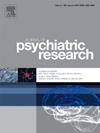Multiple emergency department visits and suicidal behavior in children and adolescents
IF 3.7
2区 医学
Q1 PSYCHIATRY
引用次数: 0
Abstract
Background
Suicidal behaviour is a growing problem in child and adolescents, and the Emergency Department (ED) is often where the first contact with Mental Health occurs. Here we factors associated with suicidal behaviour in this children and adolescents attended at the ED.
Methods
Our sample consisted of children and adolescents who attended the ED of Hospital 12 de Octubre for psychiatric reasons between January 1st and December 31st, 2022. Inclusion criteria were age under 18 years. No restrictions by diagnosis, ethnicity, nationality, gender or any other variables. We conducted an initial interview with patients in the ED and reviewed patients' digital patient records for the six months following their first visit during 2022.
Results
We found that the variables that were independently associated with a repeated visits for suicidal behaviour were eating problems, transgender identity, emotional dysregulation and previous mental health follow-up.
Conclusion
In our study, we found that ED revisits were concentrated in the first month after the first visit. Just as associated factors and approaches have historically been studied in the adult population, the child and adolescent population needs an even more in-depth study of this alarming situation.
求助全文
约1分钟内获得全文
求助全文
来源期刊

Journal of psychiatric research
医学-精神病学
CiteScore
7.30
自引率
2.10%
发文量
622
审稿时长
130 days
期刊介绍:
Founded in 1961 to report on the latest work in psychiatry and cognate disciplines, the Journal of Psychiatric Research is dedicated to innovative and timely studies of four important areas of research:
(1) clinical studies of all disciplines relating to psychiatric illness, as well as normal human behaviour, including biochemical, physiological, genetic, environmental, social, psychological and epidemiological factors;
(2) basic studies pertaining to psychiatry in such fields as neuropsychopharmacology, neuroendocrinology, electrophysiology, genetics, experimental psychology and epidemiology;
(3) the growing application of clinical laboratory techniques in psychiatry, including imagery and spectroscopy of the brain, molecular biology and computer sciences;
 求助内容:
求助内容: 应助结果提醒方式:
应助结果提醒方式:


